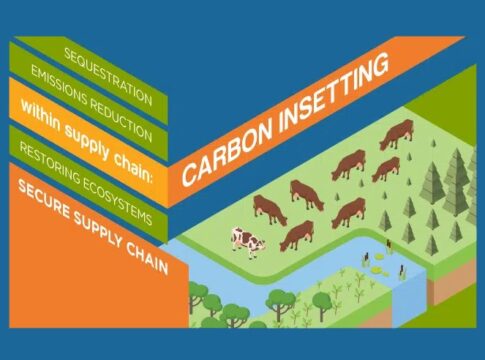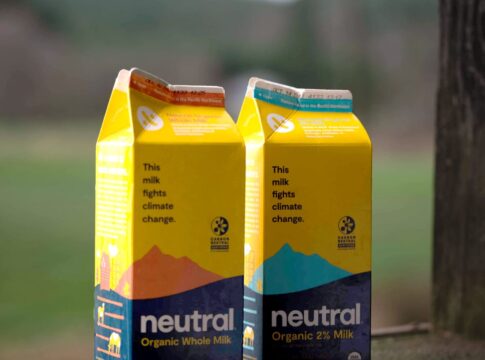Carbon Insetting: The Target of Scope 3 Carbon Offset Accounting
Carbon offsets are a well-known sustainability concept so you most likely have heard of them. But there’s a relatively new sustainable supply chain term on the block: “carbon insetting”.
Carbon insets are still undergoing their transformation. Yet, have the potential to be a significant element of the global movement of decarbonization.
This article will explain in detail what carbon insetting is and how insets differ from offsets. It will also provide some real-life examples to illustrate its application.
What is Carbon Insetting?
The critical net zero strategy suggests that companies looking to decarbonize should mitigate first then offset their unavoidable emissions. What lies between these two measures is carbon insetting.
Insets may sound or look like offsets but they also work like mitigation.
In broader terms, carbon insetting refers to the actions taken by an organization within its own value chain to fight climate change.
In a more specific sense, carbon insetting means the intentional reduction of Scope 3 emissions within a firm’s own supply chain.
So, the rub with insetting is with Scope 3 emissions, both upstream and downstream, that can count across various parties’ supply chains.
Inset emissions are directly avoided, reduced, or sequestered within the company’s value chain. They’re not sold as a credit to offset another firm’s emissions by capturing carbon somewhere else.
Carbon insetting also means investing in sustainable practices that prevent emissions from happening in the first place. They’re often nature-based projects. They don’t avoid or sequester carbon only, they also protect biodiversity and restore ecosystems.
Are carbon insets better than carbon offsets?
Both carbon measures represent ways that can help mitigate emissions. But they’re also different methods of tackling climate matters with varying impacts. So, it’s important to understand their differences.
Carbon Insets Vs. Carbon Offsets
The key difference between carbon insets and offsets is the way an entity invests to reduce its carbon footprint. Carbon insetting involves investing in projects that are related to a company’s products; carbon offsetting involves projects that are not related to a firm’s products.
In a sense, carbon insets ensure that firms take direct responsibility for the emissions in their own supply chain. They also aid in improving sustainable management practices directly at the source.
Investing in inset projects can help make a firm’s supply chain more resilient. It can also improve the quality of its raw materials.
However, carbon insets are more limited by their very nature – they only tackle Scope 3 emissions. They don’t address Scope 1 (direct emissions) nor Scope 2 (emissions from the energy that the company buys) emissions.
This means retailers selling other brand’s products or service-based businesses that don’t source raw natural materials can’t take part in carbon insets. It also means even a product-based firm can’t become carbon-neutral only by using carbon insets.
Carbon offsetting, on the other hand, is a way for entities to reduce their carbon footprint by paying money to another entity that works to reduce the total emissions emitted. Common example is planting trees.
The focus of carbon offsets is on the tonnes of carbon avoided/removed, while the focus of carbon insets is creating carbon emissions reduction capacity.
Moreover, carbon offsetting provides convenience and economic efficiency for they are from verified offset projects.
But critics claim that carbon offsets give companies “a license to pollute”. It means they allow polluters to buy offsets to pay for their footprint without actually cutting their own emissions.
Here are the other major differences between insets and offsets:
Emissions reduction generated: travels separately from the physical product with carbon offsetting while it travels with the product in carbon insetting.
As shown in the image above, farmers deliver the wheat to one party (Cargill) then deliver the quantified emissions reduction to another entity (Microsoft) under carbon offset. But under carbon inset, farmers deliver both the wheat and the emissions reduction to the same party (Cargill).
Methodology and standards: a third party like a registry (Verra, Gold Standard) or rating agency (Sylvera) set the certification standard for carbon offsets. In carbon insets, many parties involved agree on the standard used.
Intended project purpose: carbon offset projects are for the voluntary carbon market. Whereas inset projects are for specific businesses’ supply chains.
Accounting requirements: offsets are a negation of emissions already dumped into the atmosphere so they must meet rigorous standards (fungibility, additionality, durability, etc.).
On the contrary, insets don’t face the same accounting requirements as offsets do. That’s because they’re not a fungible credit like an offset.
Plus, there’s no need for addressing leakage or permanence issues as emissions through insets didn’t happen in the first place.
Overall, carbon inset represents indirect but embedded emissions reduction activities within a firm’s supply chain. Insetting activities include upstream (fuel and energy-related activities) and downstream (sold product processing).
Carbon offset represents direct but outsourced emissions reduction efforts. An entity buys an offset and outsources it to another entity that takes the project into effect.
Real-world Examples of Carbon Insetting
Carbon insets are relevant across a wide variety of industries. But they’re most significant in the food and agricultural supply chains due to these agriculture-specific conditions.
Low-carbon fruit:
Ag regenerative practices exist for decarbonizing food supply chains with nature-based, scalable climate solutions. Decarbonization in this sector has a lower cost compared to new carbon removal technologies.
Readily available financial systems:
There are existing financial mechanisms already in place that incentivize farmers to adopt ag regenerative practices. It doesn’t need to put up new payment systems.
Biggest sink:
Agricultural soils are by far the world’s largest carbon sink.
Co-benefits:
Decarbonizing food supply chains also result in other positive impacts like biodiversity, improved water and air quality, and nutritious food.
To show a concrete carbon insetting in a real-world setting, here’s an example scenario.
A farmer delivers regeneratively wheat to a downstream customer contracted by a project developer. The customer then pays a premium for the sustainable wheat and the farmer gets more revenue with an increase in price.
The illustration below shows a carbon inset value chain, from the supplier to Scope 3 reductions.
The inset suppliers are farmers that use regenerative practices to grow crops that reduce emissions and receive payment per metric tonne of carbon.
Project developers are companies that work with and support the farmers while partnering with corporations looking to deliver the insets within their supply chains.
Supplier refers to ag retailers and distributors between the farmers and downstream customers. In the example, that’s Cargill.
Customers are those who buy the raw commodities (wheat) as key ingredients in their products like AB InBev, for instance.
MRV refers to an entity that supplies data to verify carbon outcomes delivered by insetting methodology. While standards are the certification bodies that develop best practices for carbon insets.
One particular company that employs carbon insetting in its quest to net zero emissions is Burberry.
Burberry announced two years ago that it has created a “Regeneration Fund”. The aim of the fund is to support the company’s portfolio of insetting projects across its global supply chain.
The luxury fashion house partnered with PUR Project. It will put in place regenerative farming practices with Burberry’s wool producers in Australia.
The insetting project will work at farm level to improve carbon capture in soils, improve watershed and soil health, reduce dryland salinity and promote biodiversity.
Key Takeaways
For sure, insetting is not the same thing as offsetting but insets may be from offsets.
So, where do we draw the line between carbon insetting and offsetting?
Carbon offsets represent the avoidance or removal of CO2 from the atmosphere via verified projects made available on the carbon market.
While carbon insets represent the addition of nature-based projects into a company’s supply chain. Insetting doesn’t need formal verification.
Given our definition and distinction above, we can say that Scope 1 and 2 are to offsets while Scope 3 is to insets.
Without the need for additionality and permanence considerations in insets, it’s up to the producers and consumers to agree to a methodology.
Carbon insets represent indirect emission reductions. They are the execution of practices that reduce a firm’s carbon footprint outside of its direct operations but within its own supply chain.
In short, carbon insetting can be viewed as a piece of the sustainability puzzle for a company. Firms must continue to focus on their carbon emissions reduction initiatives like transitioning to renewable energy.
Lastly, carbon insets do not came into existence to replace carbon offsets. They should be used along with offsets and other emissions reduction strategies to achieve net zero emissions.
The post Carbon Insetting: The Target of Scope 3 Carbon Offset Accounting appeared first on Carbon Credits.



